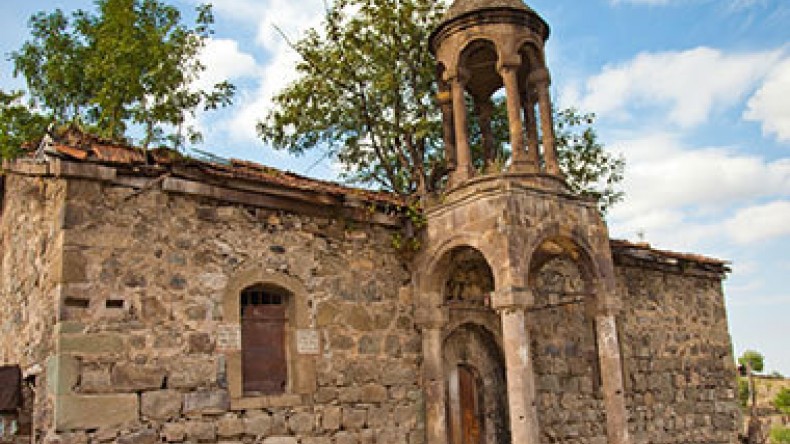
Scientific publication about village Vartashen and Udis, Armenians, Jews and Tatars living there
In the 14th issue for the year 1892 of the project “The Collection of Materials to Describe the Terrain and Tribes in the Caucasus,” Vartashen school inspector M. Bezhanov published an article dedicated to the history and life of the Udi village Vartashen (in territory of modern Azerbaijan Republic).
The village Vartashen is situated 35 versts to the north from the town Nukha on almost 2,500 feet height at the bottom of the southern slope of the Caucasus ridge, whose spurs border the village from the East and West, while a plain spreads in the South. Vartashen consists of Vartashen proper and Kishlakh-Vartashen 2 versts to the south from it, the author writes. (1 verst= 1.067 km) According to a legend, Vartashen was founded by a priest, Udi poet Vartan, and the name Vartashen means “Vartan’s village.”
Another legend claims the name of the village origins from the words “Vardis” (“rose” in Persian – ed.) and “shen” (“village” in Armenian – ed.), that is, “village of roses.” “Many roses are still growing in the surroundings,” the author notes. Numerous ancient kurgans and cemeteries both inside and around the village stand to evidence the old age of the village.
According to Bezhanov, Vartashen was inhabited by Udis (Orthodox and Gregorian), Armenians, Tatars and Jews. The Udis lived in the village Vartashen and Nij. They spoke a mountain language, which adapted many Tatarian words. The Udis, who have lived in the Caucasus since the ancient times and used to have a certain Aghvanian kingdom some time, according to a legend, “settled in various places in Asia.” Earlier, they inhabited all the villages in Nukhin uyezd, and even quite recently, there lived old people in different villages, who spoke the Udi language. The Udis adopted Christianity very long time ago, with the ruins of ancient Christian churches preserved in almost all the “Tatarian villages” on the Nukhin uyezd evidencing it.
The multitribal composition of the village was reflected in the structure of the village administration, which included the leader, three assistants to the leader, three candidates for them and four “chovushs,” that is, village watchmen. The assistants were elected from the Orthodox adherents, Jews and Tatars, one from each. The representatives from all the tribes took part in the election of the leader. The village court consisted of five people, one from Orthodox adherents, one from the Tatars, one from the Jews and two from the Gregorian adherents. All the writing was done in Armenian by a scribe.
Bezhanov’s research includes noteworthy information about the division of labor in the village. The Udis and Tatars were engaged in farming, sericulture, gardening, horticulture, cattle breeding, and partly, trade. The Armenians were engaged in trade, and the Jews in trade and cultivation of tobacco.
Every local had a garden, a land lot for farming, chaltyk (rice) growing and haymaking (by lot). The Jews did not have land; the rich were engaged in trade and the poor in cultivation of tobacco by sowing makhorka (a coarse, strong type of tobacco) on other peoples’ lands.
Vartashen also had its own education centers – two schools, public, district, and Armenian ecclesiastical. The public school was founded in 1860 by the author’s father, Stepan Bezhanov. In 1876, S. Bezhanov’s pupil, Kotev, took his office. In 1880, the author’s brother, Georgi Bezhanov was appointed as the school teacher from The Community to Recover the Orthodox Christianity in the Caucasus, and worked there until it closed down in 1883. After the closure of the Public school, the district administration funded the establishment of a two-year school in 1887.
Referring to the architecture, the author points out that the structures became better every year, getting a European look. He stresses that one of the best buildings in the village, an Orthodox church built in 1822 close to an Armenian church, was quite dilapidated. The Jews had two synagogues.
“The Collection of Materials to Describe the Terrain and Tribes in the Caucasus” is a large-scale publication of narrative sources carried out by the management of the Caucasus Educational Okrug in 1881-1908. It includes researches and description of the history, life, and ethnographic characteristics of the peoples inhabiting the Caucasus region of the Russian Empire.
Related:
Scientific publication recounts historical data about C15th Armenian village Kusapat in Artsakh
Scientific edition of Russian Empire: Nakhijevan was prominent Armenian city founded in C16 BC
19th century scientific edition of Russian Empire compiled historical data about ancient Erivan
Newsfeed
Videos






























